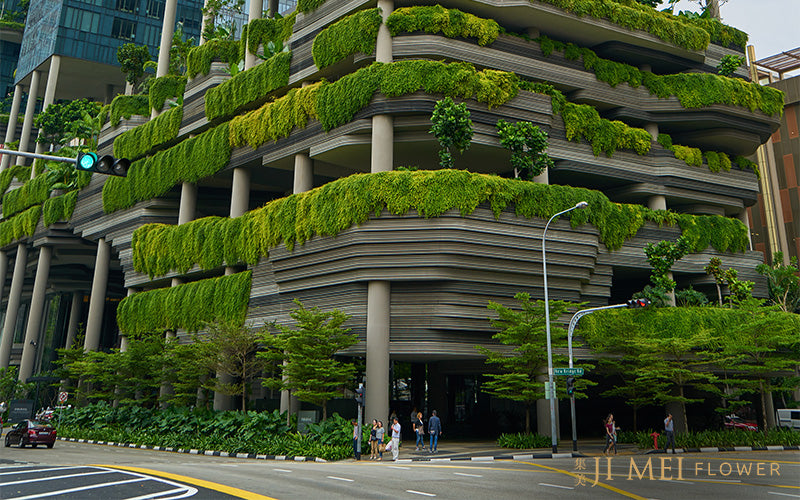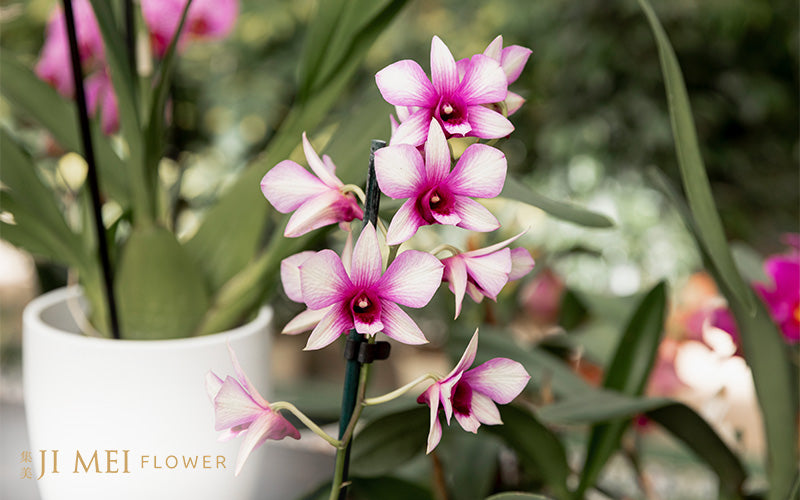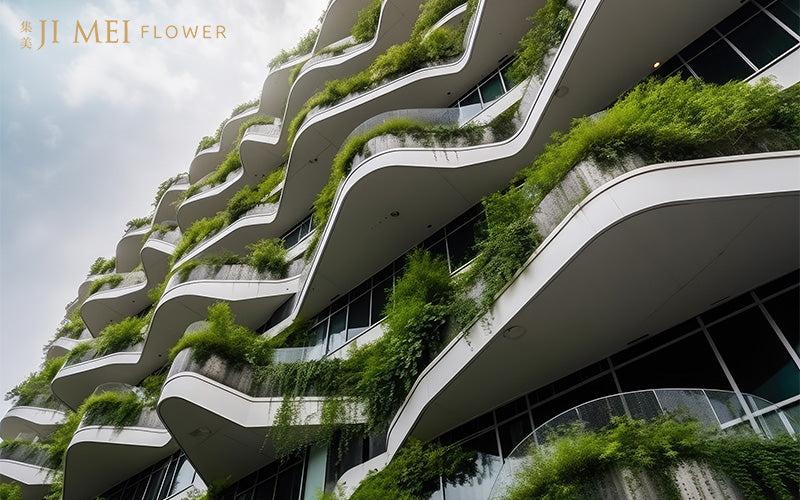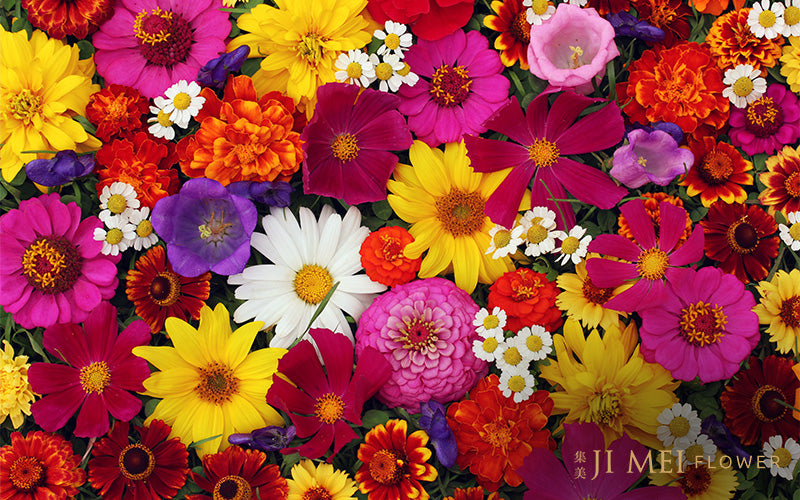In the whirlwind of fast-paced urban environments, many city dwellers often crave a connection to nature amidst the chaos of daily life. This is how flowers offer a simple yet effective solution, bridging the gap between urban living and the soothing presence of the natural world. Singapore, known for its creative urban planning, recognises the many advantages that flowers provide, and has embraced them by integrating floral elements throughout the cityscape.
In this article, Ji Mei Flower, an established provider of wholesale flowers in Singapore, examines the practical benefits of incorporating flowers into city life. Keep reading on to learn insights into how flowers play a pivotal role in enhancing urban living, providing a sense of well-being even amidst the hustle!
7 Top benefits of flowers and nature in urban settings

Flowers are delicate wonders of nature that not only add visual appeal to spaces but also offer a myriad of benefits that significantly contribute to our overall well-being. In this section, we take a look at the several key advantages that flowers bring to urban settings, spanning from therapeutic effects to environmental contributions.
Flowers and positive emotions
Even on the most challenging days, the mere sight of flowers can evoke a range of positive emotions, lifting our spirits and brightening even the gloomiest of moods. Scientific research consistently suggests that exposure to flowers enhances emotional well-being. Whether it's a cluster of blossoms adding a touch of tranquillity to the bustling streets, or a rooftop garden atop a sustainable skyscraper, these natural touches not only beautify the environment but also serve as effective relievers of anxiety, soothing the minds of city dwellers amidst their hectic routines.
Stress reduction

Feeling overwhelmed by the weight of stress in your daily life? Fortunately, flowers offer a serene sanctuary amidst the chaos, giving you a serene escape from the pressures of city living. Taking a leisurely stroll through a park for a moment of quiet contemplation, or simply basking in spaces adorned with fresh flowers can work wonders for mental rejuvenation. By immersing oneself in nature's beauty, you can emerge revitalised, armed with renewed vigour to confront the challenges of life head-on!
Natural air purifiers
In densely populated cities where air quality is often a pressing concern, the presence of flowering plants becomes paramount in mitigating pollution levels. Be it grown along sidewalks, in public areas, or indoors, these blooms act as invaluable allies in the ongoing battle for cleaner air.
With their ability to absorb pollutants such as benzene, formaldehyde, and trichloroethylene, fresh flowers are particularly indispensable in indoor spaces, where air quality can be even more compromised. Certain types of flowers also possess unique attributes that allow them to specifically target and neutralise common indoor pollutants, thereby enhancing overall air quality within homes and businesses. Furthermore, strategically integrating these natural air purifiers into outdoor spaces can support cities in enhancing the quality of life for their residents while also beautifying the environment.
Temperature regulation

Adding flowers to metropolitan areas is an essential way to reduce heat stress. Plants actively aid in cooling the environment through the process of evapotranspiration, in which they release moisture into the atmosphere through their leaves. In addition to offering instant respite from the sweltering heat, this natural cooling effect also works to mitigate the impact of the urban heat island effect, which raises temperatures in cities.
In addition, the shade provided by blooming plants and their leaves helps to further moderate ambient temperatures by limiting the amount of solar radiation that is absorbed by hard surfaces like pavement and buildings. By creating microclimates of cooler, more comfortable conditions, these plants increase the livability of metropolitan cities and promote outdoor activities even during periods of extreme heat.
Noise reduction
Plants, particularly those with lush foliage, play a significant role in mitigating noise pollution in busy cities. Their dense foliage acts as a natural shield, adeptly absorbing and deflecting sound waves, consequently reducing overall noise levels. This strategic planting of flowers in parks, along roadways, and in other green spaces enables cities to effectively curb urban disturbances such as construction noise and traffic. As a result, bustling cities become more tranquil and serene, resulting in quieter, more peaceful landscapes that foster a sense of harmony and well-being.
Community building
Engaging in community gardening projects or beautification efforts centred around flowers provides residents with opportunities to connect, collaborate, and cultivate a sense of belonging. Through working together to tend to communal green spaces, participants build relationships, exchange knowledge, and strengthen community bonds. As individuals work side by side in these communal spaces, they not only beautify their surroundings but also create a sense of ownership and pride in their shared environment.
Environmental education
Incorporating flowering plants into urban landscapes provides opportunities for environmental education and awareness. For instance, interpretive signage strategically placed in green spaces adorned with flowering plants allows the public to learn about the various species of flora present, their ecological roles, and the benefits they provide to urban ecosystems.
Guided tours led by knowledgeable experts also offer participants the chance to explore these gardens firsthand, while educational programs provide in-depth insights into topics such as pollination, habitat preservation, and water conservation. By fostering environmental literacy and promoting a deeper understanding of the natural world, cities can empower individuals to make informed choices that contribute to the health and sustainability of the home they live in.
Practical ways to incorporate flowers into urban living
Despite the limited space and challenges present, there are practical ways to integrate flowers into urban environments, adding aesthetic appeal and promoting well-being. From rooftop oasis to vertical green installations, let’s explore practical strategies to effectively weave in flowers into city living!
Indoor gardening

If you’re looking for ways to harness the beauty of flowers to elevate your homes or commercial buildings, indoor gardening might just be the answer! Opting for hanging pots or wall-mounted planters allows you to maximise vertical space, making the most of limited room. Compact and low-maintenance blooms such as roses, orchids, and daisies are also great options that thrive in indoor environments, adding pops of colour and natural charm to living spaces easily. With proper care and attention, indoor gardens can also provide a refreshing retreat from the urban hustle, fostering a connection with nature within the confines of your interior.
Learn more: 3 Flowers and Plants to Enhance Feng Shui With | Ji Mei Flower
Rooftop gardens
For urbanites craving a connection to nature, rooftop gardens offer a serene escape within the bustling cityscape. Implementing raised beds or containers allows for the cultivation of a variety of flowers and herbs, transforming your rooftop into a lush oasis. From cheerful daisies to fragrant lavender, these gardens offer an array of possibilities to delight the senses. Additionally, incorporating comfortable seating areas, charming pergolas, and pathways aids in creating inviting outdoor spaces perfect for relaxation, entertaining, and immersing in the beauty of the botanical haven.
Whether serving as a sanctuary for personal rejuvenation, a venue for social gatherings, or a hub for sustainable urban agriculture, rooftop gardens elevate the livability of urban spaces while championing environmental sustainability.
Vertical gardens

Vertical gardens, also known as green walls or living walls, are eye-catching and space-saving methods for integrating floral elements into urban landscapes. These installations not only add beauty to their surroundings but also boast versatility, fitting snugly into spaces like narrow alleyways and balconies, often doubling as privacy screens and sound barriers.
Through utilising modular systems or hydroponic technology, vertical gardens can also be effortlessly incorporated onto building exteriors, effectively transforming barren concrete spaces into vibrant green sanctuaries. Choose a variety of flowers, ferns, and mosses to create a diverse and dynamic mix of textures and colours that enhances the visual appeal of buildings, as well as helping to reduce carbon emissions in the environment.
Rain gardens
Rain gardens, integral to green infrastructure, provide a dual solution to urban stormwater challenges while enhancing aesthetic appeal. Designed to capture rainwater runoff, these gardens promote its absorption into the soil, naturally filtered by lush plant life. This process not only reduces the volume of stormwater entering sewer systems but also addresses issues such as flooding, erosion, and water contamination.
Typically featuring shallow depressions planted with a diverse selection of native flora and grasses, rain gardens create welcoming habitats for various wildlife, including birds and bees. These gardens can be seamlessly integrated with other green infrastructure techniques, bolstering the effectiveness of stormwater control initiatives.
Flower boxes
Strategically placed along sidewalks, building facades, and public spaces, flower boxes are lovely additions that not only add a vibrant splash of colour but also contribute to creating a welcoming environment. From lush ferns to delightful hydrangeas, the options are endless! However, beyond their visual allure, and environmentally sustainable benefits, flower boxes play practical roles in Singapore's urban environment. They soften the harsh edges of buildings, helping to improve the cityscape, and act as natural barriers, demarcating pedestrian paths and providing a sense of safety and segregation from moving cars.
Floral wall art

Enhancing commercial spaces with floral wall art offers a dynamic approach to boosting brand identity, fostering positive atmospheres, and enriching customer experiences. By carefully selecting floral arrangements that align with the brand's essence, businesses can create a cohesive visual identity that resonates with both clients and employees.
For instance, research has shown that being among flowers can improve mood, lower stress levels, and improve cognitive function. These benefits cultivate inspiring work atmospheres that boost creativity and productivity. Additionally, companies may improve consumer experiences by creating immersive, Instagram-worthy spaces that entice, engage, and evoke positive brand sentiment, thereby nurturing brand recognition and customer loyalty. Whether through elaborate installations or cascading arrangements, a floral wall art can serve as captivating centrepieces that infuse spaces with sophistication and personality!
The community and social impact of flowers in urban settings

Urban spaces are often characterised by bustling streets, towering skyscrapers, and concrete jungles. Amidst this urban hustle and bustle, the inclusion of flowers serves as a gentle reminder of nature's beauty, offering a moment of respite and connection for city dwellers. In this section, we go deeper into why the significance of flowers in cities has garnered attention not only for their aesthetic appeal but also for their profound impact on community bonding and social enrichment.
Artistic expression and inspiration
Flowers have long been a source of inspiration for artists, poets, and creatives around the world. In fact, urban artists continue to draw inspiration from the natural world, using flowers as symbols of beauty, resilience, and hope in their work. From intricate botanical illustrations to larger-than-life floral murals, these artistic expressions serve to beautify modern spaces and evoke a sense of wonder and delight among passersby. Additionally, they also help to contribute to the cultural richness and visual diversity of cities, transforming dull concrete walls into vibrant canvases that spark joy and inspiration.
Access to green spaces for social equity
Ensuring access to green spaces and floral displays is not only a matter of urban planning but also a fundamental aspect of promoting inclusion in Singapore. In our little citystate, where land scarcity is a challenge, the development of green spaces takes on added significance as these areas serve as vital communal hubs for relaxation, recreation, and social interaction. By strategically integrating parks, gardens, and green corridors into urban planning initiatives, the government aims to enhance the quality of life for Singaporeans while fostering a sense of belonging and community cohesion.
For example, the Community in Bloom programme, launched in 2005, encourages residents to come together and decorate their neighbourhoods through gardening and landscaping activities. From planting flowers and ornamental plants to creating mini herb gardens and community orchards, residents take pride in beautifying their surroundings and instilling community spirit and pride in them.
Similarly, the Gardening with Edibles initiative promotes urban agriculture and food sustainability by encouraging residents to grow their own fruits, vegetables, and herbs in urban spaces. By transforming unused rooftops, vacant lots, and public spaces into productive gardens, residents not only promote self-sufficiency and resilience but also contribute to food security and environmental sustainability in their neighbourhoods.
Celebrating Singapore’s unique flora and fauna
Singapore's tropical climate provides a conducive environment for a wide variety of flora, ranging from orchids and bougainvillaea to frangipani. These native plants contribute to the aesthetic appeal of Singapore's urban landscape while also highlighting the country's rich botanical heritage. The Singapore Botanic Gardens, a UNESCO World Heritage Site, stands out for its remarkable collection of orchids and tropical specimens, symbolising Singapore's dedication to safeguarding its biodiversity. By incorporating native plants into urban landscapes and public spaces, Singapore not only enhances its natural beauty but also promotes environmental conservation and sustainability, reinforcing the importance of preserving and appreciating the country's unique flora and fauna.
Questions you may have

From rooftop gardens to vertical green installations, there are practical solutions that urbanites can embrace to infuse their surroundings with the vibrant allure of greenery and flora. Here, we answer some common questions you may have surrounding integrating flowers into city living, to enhance aesthetics, promote well-being, and foster environmental sustainability. Read on to learn more!
Are there low-maintenance flowers suitable for busy lifestyles?
Absolutely! Many flowers are well-suited for busy urban dwellers who may not have ample time for intensive gardening. Low-maintenance options like succulents, cactus, and marigolds require minimal care and can thrive in various indoor and outdoor environments. These resilient plants can also handle changes in watering schedules and tolerate a range of light conditions, making them ideal choices for those with hectic lifestyles.
Are there flowering plants that can bloom year-round indoors?
While many flowering plants have specific blooming periods, some species can bloom year-round indoors with proper care. Examples of flowering plants known for their continuous blooming include African violets, orchids, and certain types of begonias. However, these plants require consistent light, temperature, and watering conditions to maintain continuous flowering such that the beauty of these blooms can be enjoyed indoors throughout the year.
How do flowers in urban environments attract wildlife and support biodiversity?
Flowers in urban environments attract wildlife and support biodiversity by providing essential food sources for pollinators such as bees, butterflies, birds, and even bats. As these visitors go from flower to flower gathering nectar and pollen, they transfer pollen between blooms and enable the reproduction of plants. This relationship is essential for the survival of both plants and the diverse array of animals that rely on them for sustenance.
Beyond their role in providing sustenance, flowering plants also contribute significantly to climate regulation. Through photosynthesis, they absorb carbon dioxide from the atmosphere and release oxygen, a vital component for all living organisms. Additionally, plants actively counteract the effects of climate change by storing carbon from the environment through their soil and tissues, thus helping to offset the accumulation of greenhouse gases in the atmosphere.
Can flowers in urban environments help mitigate the urban heat effect?
Yes, flowers and other vegetation in urban environments play a crucial role in mitigating the urban heat island effect. This effect occurs when cities experience significantly higher temperatures than surrounding rural areas due to factors such as the absorption and retention of heat by buildings and pavement, as well as the lack of vegetation.
Flowers and plants help combat this heat by providing shade, cooling the surrounding air through a process called transpiration, and reducing the amount of heat absorbed by surfaces like rooftops and pavement through evapotranspiration. Additionally, green spaces like parks and gardens act as natural cooling agents by creating pockets of cooler air and reducing overall temperatures in modern cities.
How should I choose and combine the right flowering plants?
When selecting and combining flowering plants for your garden, several considerations can help create a vibrant and visually appealing space. Firstly, consider each plant's blooming season to guarantee a year-round show of colour. By strategically choosing species that bloom in different seasons, you can maintain a lively garden from spring to fall. Subsequently, you may consider utilizing contrasting colors to enhance the visual impact of your flower beds. Incorporate fragrant plants like roses, lavender, and jasmine to infuse delightful scents and attract beneficial pollinators.
Additionally, you should pay attention to plant height, using taller varieties to create a backdrop for shorter ones and introducing hanging plants for added dimension. Lastly, keep in mind that foliage plays an important role in the aesthetics of a garden so choose plants with intriguing leaf textures and forms to contrast with the flowers and add emphasis points to your garden’s design.
How should I prevent pests and disease from affecting my flowering plants?
One way to eliminate hiding places for pests and promote the overall health of your plants is by maintaining good gardening practices through regular weeding, pruning, and performing other routine maintenance tasks. Additionally, diversifying the types of plants you grow through crop rotation and companion planting introduces a variety of plants to your garden, making it less favourable for pests to target their preferred host plants and reducing the risk of infestation.
Conclusion
In conclusion, integrating flowers into urban lifestyles offers a plethora of benefits that extend far beyond mere aesthetics. Whether through cultivating rooftop gardens, beautifying city parks, or incorporating floral arrangements into indoor spaces, embracing flowers can profoundly impact our physical and emotional health while contributing to the vibrancy and sustainability of urban living, fostering a deeper appreciation for the natural world amidst the hustle and bustle of city life.
Wondering where to buy flowers to infuse your living spaces with the beauty of nature? Look no further than Ji Mei Flower, your trusted flower supplier in Singapore! Whether you're seeking to create a rooftop oasis, add a touch of nature to your indoor environment, or simply enjoy the therapeutic benefits of flowers, we have the perfect selection for you. Reach out today to discover our stunning array of blooms that will guarantee to elevate any environment!

